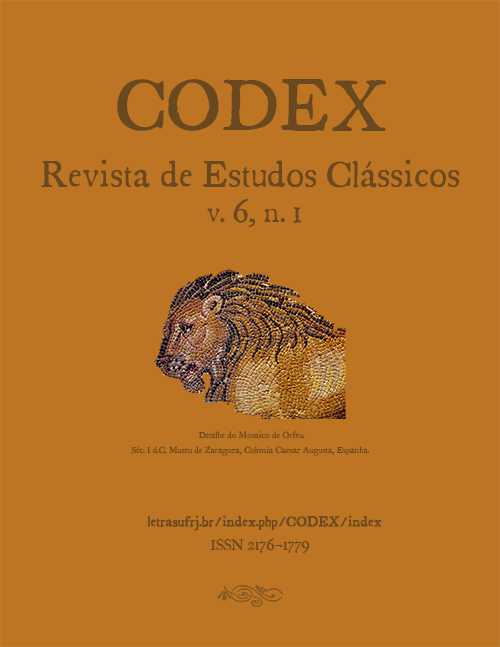Busíris, um drama satírico de Eurípides
DOI :
https://doi.org/10.25187/codex.v6i1.15237Mots-clés :
Busíris, Héracles, Eurípides, drama grego, drama satírico, fragmentosRésumé
Busíris é um dos dramas satíricos de Eurípides, incompleto e de data incerta. Este artigo contém um panorama dos mitos sobre Héracles e Busíris e sua iconografia; a tradução dos testemunhos e fragmentos conhecidos; e uma reconstrução conjetural do drama satírico, baseada nos escassos dados disponíveis.Téléchargements
Références
ALLAN, W. Euripides Helen. Cambridge: Cambridge University Press, 2008.
BERTI, M. “L'Egitto nella commedia greca”. Aegyptus, v. 82, 2002, pp. 93-112.
BRAUN, T. “The greeks in Egypt”. In: BOARDMAN, J. & HAMMOND, N. (Ed.). The Cambridge Ancient History. Cambridge: Cambridge University Press, 1982, pp. 32-56.
BURKERT, W. Religião grega na época clássica e arcaica. Trad. M. J. Simões Lourei-ro. Lisboa: Calouste Gulbenkian, 1993 [1977].
CARREZ-MARATRAY, J-Y. “Bousiris, le pharaon inexistant, et le stéréotype grec du roi juste”. In: GRANDIÈRE, M. & MOLIN, M. (Ed.) Le stéréoty¬pe, outil de régulations sociales. Rennes: Presses Universitaires de Rennes, 2004, pp. 201-212.
COCKLE, H. M. (Ed.). The Oxyrhynchus Papyri, v. LII (Graeco-Roman Memoirs, 72). London: Egypt Exploration Society, 1984, pp. 17-22.
COLLARD, C. & CROPP, M. Euripides fragments, 2 v. Cambridge MA / London: Harvard University Press, 2008.
FROIDEFOND, C. Le mirage égyptien dans la littérature grecque d'Homère à Aristote. Aix-en-Provence: Ophrys, 1971.
FURTWAENGLER, A. & REICHHOLD, K. Griechische vasenmalerei: auswahl her-vorragender vasenbilder (Serie I, Tafeln). München: Bruckmann, 1904.
GEACH, J. The Euripidean Prologue. Dissertação (Master in Art). Department of Clas-sics, The University of Arizona, Tucson, 2016.
HAMILTON, R. “Prologue Prophecy and Plot in Four Plays of Euripides”. American Journal of Philology, v. 99, n. 3, 1978, pp. 277-302.
HARDER, A. Callimachus Aetia: introduction, text, translation and commentary, v. 1. Oxford: Oxford University Press, 2012.
HARTUNG, J. A. Euripides restitutus, v. alterum. Hamburg: Freiderich Perthes, 1844.
HOLLIS, A. S. Ovid Ars Amatoria, Book I. Oxford: Oxford University Press, 1977.
KANNICHT, R. Tragicorum Graecorum Fragmenta, v. 5.1 (pars prior) / v. 5.2 (pars posterior). G¶ttingen: Vandenhoeck & Ruprecht, 2004.
LAURENS, A-F. “Bousiris”. In: Lexicon Iconographicum Mythologiae Classicae, v. III. Zurich / München: Artemis, 1986, pp. 147-152.
LIVINGSTONE, N. A commentary on Isocrates' Busiris (Supplementum Mnemosyne, v. 223). Leiden: Brill, 2001.
LUPPE, W. “Zu einer Stobaios-Stelle aus Euripides”. Hermes, v. 116, n. 4, 1988, pp. 504-5.
LLOPIS, J. S.; GÓMEZ, R. M. & ASENSIO, J. P. Fragmentos de la Comedia Media. Madrid: Gredos, 2007.
MILLER, M. C. “The myth of Bousiris: ethnicity and art”. In: COHEN, B. (Ed.). Not the classical ideal: Athens and the construction of the other in greek art. Leiden: Brill, 2000, pp. 413-42.
MITCHELL, A. G. Greek vase-painting and the origins of visual humour. Cambridge / New York: Cambridge University Press, 2009.
NAUCK, A. Tragicorum graecorum fragmenta, editio secunda. Lipsiae: Teubneri, 1889.
NIMIS, S. “Egypt in graeco-roman history and fiction”. Alif: Journal of Comparative Poetics, Cairo, v. 24, 2004, pp. 34-67.
OLSON, S. D. Broken laughter: select fragments of greek comedy. Oxford: Oxford University Press, 2007.
O'SULLIVAN, P. & COLLARD, C. Euripides Cyclops and major fragments of greek satyr drama. Oxford: Oxbow, 2013.
PAPILLON, T. L. “Rhetoric, art and myth: Isocrates and Busiris”. In: WOOTEN, C. W. & KENNEDY, G. A. (Ed.) The orator in action and theory in Greece and Rome (Su-pplementum Mnemosyne, v. 225). Leiden: Brill, 2001, pp. 73-96.
PEARCE, S. J. K. The land of the body: studies in Philo's representation of Egypt. Tübingen: Mohr, 2007.
RIBEIRO JR., W. A. “Notas sobre os dramas satíricos fragmentários de Eurípides”. In: SANTOS, F. B. & OLIVEIRA, J. K. (org.) Estudos Clássicos e seus desdobramentos: artigos em homenagem à Professora Maria Celeste Consolin Dezotti. São Paulo: Cultu-ra Acadêmica, 2015, pp. 165-182.
ROUMPI, A. “The killing of Bousiris: the vase-painter's idea of the musicians in the service of an egyptian king”. Imago Musae, v. 24, 2011, pp. 23-42.
TOVAR, S. T. “Greek in Egypt”. In: BAKKER, Egbert J. (Ed.) A Companion to the Ancient Greek Language. Oxford: Wiley & Sons, 2010, p. 253-66.
VAN LOOY, H. “ΒΟΥΣΙΡΥΣ ΣΑΤΙΡΙΚΟΣ -- Busiris, drame satyrique”. In: JOUAN, F. & _____. Euripide, tragédies tome VIII 2e partie: Fragments de Bellérophon à Pro-tesilas. Paris: Les Belles Lettres, 2002, pp. 37-47.
VASUNIA, P. The gift of the Nile: hellenizing Egypt from Aeschylus to Alexander. Ber-keley / Los Angeles: University of California Press, 2001.
WILAMOWITZ-MOELLENDORFF, U. von. Kleine schriften, v. 1. Berlin: Weidmann, 1937 [1906].
WILKINS, J. The boastful chef: the discourse of food in ancient greek comedy. Oxford: Oxford University Press, 2000.
Téléchargements
Fichiers supplémentaires
Publiée
Comment citer
Numéro
Rubrique
Licence
A Codex - Revista de Estudos Clássicos utiliza uma licença Creative Commons - Atribuição-NãoComercial 4.0 Internacional.
Os autores dos trabalhos aprovados autorizam a revista a, após a publicação, ceder seu conteúdo para reprodução em indexadores de conteúdo, bibliotecas virtuais e similares.
A revista se permite o uso dos trabalhos publicados para fins não comerciais, incluindo o direito de enviar o trabalho para bases de dados de acesso público.










